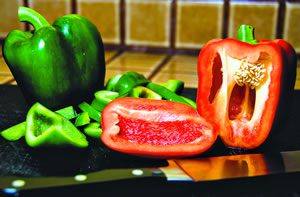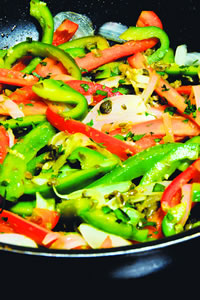Sweet Organic Bell Peppers

Dylan Strong masterfully grows Hawaii’s difficult crops. Daniel Lane photos
Dylan Strong’s Growing Strong Farm uses organic techniques to grow some of Hawai’i’s difficult crops.
What’s growing now: Apple bananas, basil, beef- steak tomatoes, bell peppers, beets, carrots, cilantro, kale, lettuce.
BELL PEPPER
Peppers are not pepper. The plant that produces dried peppercorn is native to Asia, and unrelated to the juicy peppers found in the produce isle.
The name was given by Spanish explorers who seemingly confused the spicy flavor in some peppers, with peppercorns. Bell peppers have no “bite” because of a recessive gene that eliminates capsaicin. They are botanically fruits, but generally considered in culinary contexts to be vegetables.
Bell peppers are boxy in shape, and juicy with a crisp, refreshing taste. They come in a variety of colors including green, white, yellow, orange, brown, purple and red.
A red bell pepper is a mature green bell pepper and the sweetest of the bells.
Season: Bell peppers can be grown year-round on Kaua’i and take about 90 days from seed to table.
What to look for: Fresh peppers should be wellshaped, firm and glossy. Their skins should be taut and unwrinkled, their stems fresh and green. They should feel heavy for their size.
Bell peppers made the Environmental Working Group’s “Dirty Dozen” pesticide list, but you can happily eat Dylan’s peppers knowing they’re pesticide-free!

For ease in cutting, stand up the pepper and slice off one side, then rotate and repeat
Storage: Store unwashed peppers in a bag in the refrigerator for up to a week.
Tip: The easiest way I have found to cut a pepper is to stand it up, and from top to bottom, slice off one side. Rotate, and do this three more times until you have four “pepper steaks.” Discard the core. Lay the pepper skin side down and run the tip of a knife between the soft membrane and flesh to remove additional seeds, then slice as the recipe dictates.
Preparation: Bell peppers are equally good cooked or raw. In the rustic Cajun cuisine of Louisiana, it is the third component in the “holy trinity” which includes onions and celery. These vegetables are cooked down and used as a base for dishes such as gumbo and étouffée.
Peppers can be stuffed and baked, blanched for cold salads, sautéed in oil or stock, or stir-fried. Roasting intensifies their sweetness and adds a smoky flavor. For a delicious fat-free sauce to accompany poultry or pasta, puree roasted red bell peppers with garlic, onion and herbs. For a creamy version, add yogurt.
Health benefits: Bell peppers are rich in vitamin C and antioxidants. By weight, green bell peppers have twice as much vitamin C as citrus fruit, and red bells have three times as much. Macular degeneration, bronchitis, colds, asthma, respiratory infections, cataracts, atherosclerosis, cancer and angina are aided by consuming peppers.
Study results from the University of Cordoba, Spain, conclude that capsiates in sweet peppers target a variety of pathways involved in cancer development and inflammation, and have considerable potential for dietary health benefits.
Growing Strong Farm’s produce can be found at: Farmers Market: Kapa’a Wednesdays at 3 p.m. Restaurants: Caffé Coco, Oasis on the Beach, and local produce distributor, Cultivate. Call 634-3768.

Piquant Pepper Saute. Daniel Lane photo
PIQUANT PEPPER SAUTE
Sautéed peppers are sweet and juicy, garlic and capers lend a spicy zing. This is a quick side dish for fish, chicken, or beef. You could also heap it on seared tofu. If you happen to have leftovers feel free to use in pasta, your morning eggs, or in a wrap with hummus.
* 3 bell peppers, any color, sliced thin
* 2 garlic cloves, minced
* 1 onion, sliced thin
* 1 tablespoon capers
* 1 tablespoon minced fresh herbs (such as parsley, basil or dill)
* salt and freshly ground black pepper, to taste
* 3 tablespoons extravirgin olive oil
Heat olive oil in pan over medium-high heat.
Add onion, stirring occasionally, about four minutes.
Add the peppers and season with salt and pepper.
Cook another three or four minutes, until peppers are bright and begin to soften.
Add capers and garlic and sauté until fragrant, about 30 seconds.
Toss in herbs and serve.
Makes four servings.



